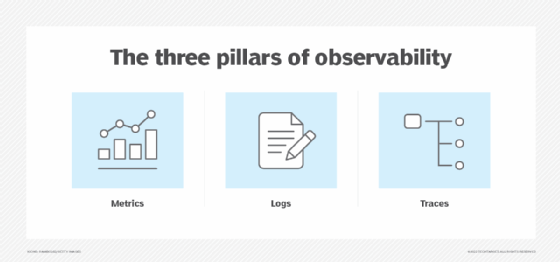
Gorodenkoff - stock.adobe.com
Manage complex IT environments with AIOps and observability
As IT environments grow in complexity, AIOps and observability tools can provide valuable insights and identify problem areas -- but prepare for adoption hurdles along the way.
As organizations look to improve their operations and development processes, interest in AIOps and observability continues to grow. But although these technologies are becoming more accessible, both present deployment benefits and challenges.
AI and observability can help IT ops teams build highly automated, secure and self-healing data centers that are more resilient and efficient. These technologies can also accelerate and improve key aspects of the development process, such as code generation, security testing, QA, bug detection and troubleshooting.
Together, AIOps and observability tools can reinforce and augment each other's capabilities and help organizations map, observe and manage increasingly complex IT environments. Due to the exponential increase in data and growing IT complexity, C-suite and IT leaders should begin strategizing pathways to adopting AIOps and observability.
Deploying AI to improve IT ops
AI for IT operations (AIOps) is a key component of automation. AIOps platforms proactively and automatically improve and repair IT issues based on aggregated information from a range of sources, including systems monitoring, performance benchmarks, job logs and other operational sources.
With AIOps, IT teams can automatically monitor hardware performance, extend usability, detect capacity losses and avoid service degradation. These capabilities are essential to meet the complexity of distributed services and ensure high availability in the data center.
By using AI with predictive analytics, IT teams can accurately maintain an enormous number of physical servers and storage assets. In the area of infrastructure, IT teams can use AI to improve power management and control. In addition to optimizing performance, AI tools can help distribute workloads across servers for greater efficiency.
Moreover, smart sensors on equipment can avert data center failures by triggering automatic repairs and notifying administrators of defects. These AI features not only reduce downtime, but also help prevent system failures that adversely affect business productivity and customer service delivery.
At the organizational level, businesses can compensate for staffing shortages through IT automation or upskill employees with AI-led training. And in terms of security, AI tools can proactively detect network anomalies and actively plug holes in network defenses.
Modernize development with observability
Observability provides context and key insights to improve all stages of the development process.
Unlike the reactive -- and limited -- traditional approach to IT monitoring, observability tools collect granular telemetry data and employ metrics, logs and traces to gain visibility into complex systems. They then apply and contextualize that intelligence to support more informed IT decision-making.

The wide scope of observability enables DevOps teams to test systems and identify potential problems early in the development process, which in turn enhances collaboration among developers, QA and IT ops. Observability practices therefore eliminate the siloed development limitations characteristic of traditional Waterfall approaches and support the Agile frameworks that are critical to building distributed applications.
By regularly gathering performance feedback from observability tools, DevOps teams can identify problems and improve applications over time through continuous iteration. Observability can also improve the quality and accuracy of requirement documents, helping guarantee the integrity of the final product and keeping deliverables on schedule.
The benefits of AIOps and observability
Combining AIOps with observability enhances the capabilities of AIOps platforms by reducing operational noise from countless alerts and pinpointing previously undiagnosed problems.
Observability provides specific performance data and useful context for developers looking to uncover potential problems in a software product. AIOps-assisted observability makes it possible to correlate data trends to specific services and then diagnose their health, preempting failures through behavior analysis and functionality assessments. This approach not only makes IT more reliable, but also ensures a consistent end-user experience.
Developers can gather telemetry to identify and address issues in new code and gain insights early in the development process. Combining AIOps with observability can further improve code generation through autosuggestion of snippets and code lines.
Other benefits of AIOps and observability include the following:
- More effective bug detection.
- Better security testing and triage.
- Improved QA.
- Effective troubleshooting for already-released products.
Challenges to adopting AIOps and observability in IT
Today's AI infrastructures incorporate machine learning as well as mathematical models. Through careful planning, organizational leaders can gain a full understanding of the scalability requirements that will enable their AI deployments to grow over time. But they can only achieve fully mature use cases if they begin with a clear end goal and choose to process the data where it lives.
Delivery times to provide AI systems can be lengthy, which is why companies often turn to cloud providers. However, effective AI deployments are iterative and long term, requiring continually updated neural network models that incorporate new data and patterns. These factors influence whether an organization chooses a public or hybrid cloud approach, which might entail hosting AI hardware on premises and require the right network backbone with low latencies and high bandwidths.
Another adoption hurdle is training algorithms that use multiple-GPU systems, as they require ultra-high-speed network connections that extend to storage infrastructure. Yet IT leaders should also understand that not every AI deployment requires GPUs; having an adaptive and flexible compute environment is key.
These adoption challenges become more acute as IT leaders juggle available CPU power, memory and network bandwidth to reach an optimal balance. Evaluating possible bottlenecks ahead of time is critical: AI located in the data center means DevOps teams must schedule and share AI resources among IT teams, developers and data scientists. Both IT and C-suite leaders must account for all these variables as they look to improve their operations and development processes.








